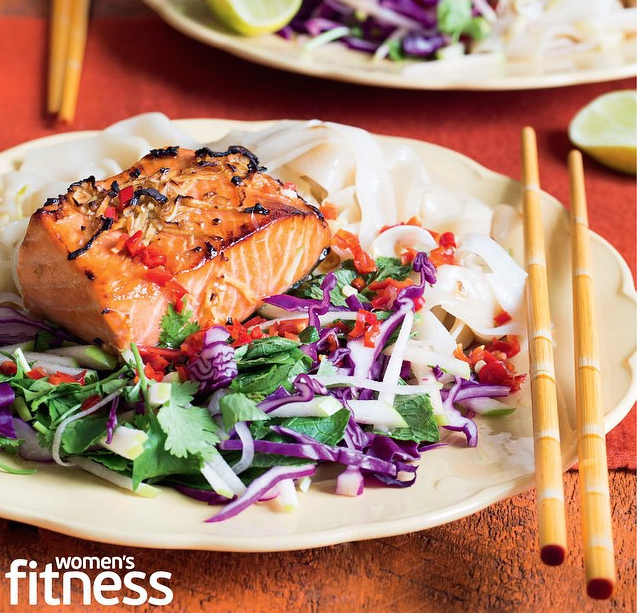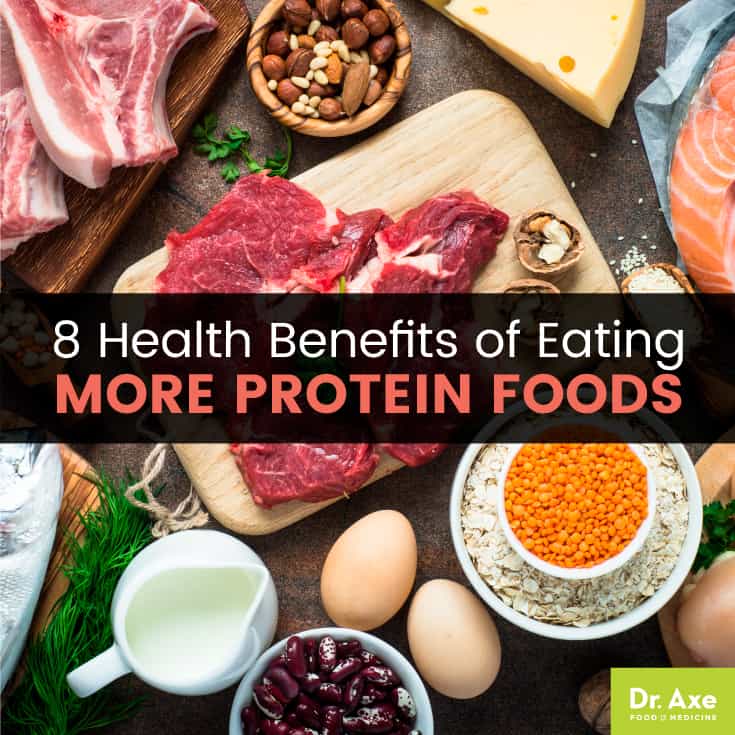
Did you know that your organs, tissues, muscles and hormones are all made from proteins? The protein found in foods is used by every part of the body to develop, grow and function properly. It can be argued that nothing is more important than consuming protein foods, and because proteins are involved in just about every body function, it’s important that you consume foods high in protein every day, during every meal to prevent protein deficiency, which can wreak havoc on the body.
Studies show that eating a high-protein diet has a number of health benefits. Not only does it help you maintain and lose weight, but it also works to stabilize your blood sugar levels, improve your ability to learn and concentrate, reduce brain fog, boost your energy levels, support your muscles and bones and support the absorption of important nutrients. (1)
Many people make the mistake of trying diets that involve calorie counting and deprivation. On a high-protein diet, you will feel completely satiated after eating, and you won’t have to deal with the blood sugar highs and lows that lead to cravings and moodiness. You’ll be surprised to see how many foods you can eat on a high-protein diet. Even people on a vegetarian or vegan diet, who sometimes turn to processed foods for energy, have enough high-protein foods to choose from.
We need to eat plenty of protein foods every day to keep our metabolisms running, our energy up and our blood sugar levels stable. You might eat enough protein overall, but do you eat the right kinds? Let’s take a look at some of the best protein foods for health.
Top 11 Protein Foods to Include in Your Diet
1. Grass-Fed Beef: 3 ounces: 22 grams
Grass-fed beef is one of the best high-protein foods that you can find. Not only does it supply almost 50 percent of your recommended daily value of protein, but it’s also a rich source of vitamins A and E and powerful antioxidants. Grass-fed beef nutrition has been shown to reduce the risk of heart disease and improve blood sugar levels due to its protein and healthy fat content. (2)
2. Organic Chicken: 3 ounces: 21 grams
One chicken breast supplies over 30 percent of your recommended daily value for protein, making it an excellent high-protein food option that can easily be added to healthy lunch and dinner recipes. Chicken is also a source of B vitamins, like niacin and vitamin B6, which are important for lowering your risk of cardiovascular disease, treating diabetes, supporting the health of your brain and lowering LDL cholesterol levels. Choose organic chicken to ensure that the chicken was fed organic food grown with no pesticides, received no antibiotics and was given access to the outdoors. (3)
3. Bone Broth: 1 serving (¼ cup): 20 grams
Protein powder made from bone broth is packed with protein and powerful amino acids that support gut integrity and detoxification. It also contains beneficial minerals, including potassium, calcium, selenium and magnesium. With just one serving of this protein powder, you ingest the healing benefits of bone broth like improving joint health, reducing cellulite, boosting your immune system and treating leaky gut.
4. Lentils: 1 cup: 18 grams
Eating lentils is a great way for vegetarians and vegans to get enough protein in their diets. A cup of lentils checks a lot of boxes off the nutrient list, including protein, fiber, folate, manganese, iron, phosphorus, potassium and B vitamins, just to name a few. The protein in lentils helps boost cardiovascular health, aid digestion, regulate blood sugar levels, and alkalize the body and balance its pH level. (4)
5. Wild-Caught Salmon (and other wild fish): 3 ounces: 17 grams
Wild-caught salmon is one of the healthiest foods around because it’s high in protein, omega-3 fatty acids, and a slew a vitamins and minerals — including vitamin B12 (with well over 100 percent of your daily value from a 3 ounce piece); vitamin D; selenium; vitamins B3, B6 and B5; and potassium. The benefits of salmon nutrition promote the health of your entire body, including your brain, bones, heart, eyes, skin and cells. (5)
6. Black Beans (and other beans): 1 cup: 15 grams
Black beans are another high-protein food that can be consumed by people following a vegetarian or vegan diet. Black beans are an excellent source of both protein and fiber, which can help to make you feel full and satisfied after eating, while also controlling your blood sugar levels so you don’t experience blood sugar highs and lows. The protein and fiber duo found in black beans also helps the body absorb nutrients and release acids into the bloodstream, which makes you feel energized and helps to cleanse your digestive tract. (6)
7. Natto: ½ cup: 15 grams
Natto is a fermented food that’s made by soaking whole soybeans, steaming them and adding healthy bacteria into the mixture. Natto offers an array of health benefits due to its protein, manganese, iron, copper, magnesium, vitamin K and vitamin C (just to name a few) content. The smell and texture of natto take some getting used to, but I suggest that you give it a try in order to take advantage of this nutrient-dense, probiotic, high-protein food. (7)
8. Eggs: 1 large free-range egg: 7 grams
Did you know that eggs have a complete amino acid profile? That means eggs contain all nine of the essential amino acids that we need to get from our food. Add eggs to your diet to boost your heart health, aid in weight loss, prevent metabolic syndrome and boost skin health. Not to mention, eggs are rich in biotin, which helps improve protein absorption. Vitamin B6 also plays an important role in protein absorption as it helps enzymes break down the protein and carries the disassembled amino acids to the blood.
But keep in mind, to get the full health benefits of eggs, stick to organic, free-range eggs, which guarantee the hens are allowed to roam, wander, perch and have a good quality of life. Plus, free-range eggs, when compared to eggs from caged hens, contain more vitamins and omega-3 fatty acids and less cholesterol. (8)
9. Yogurt or Kefir: 6 ounces: 6–9 grams
Yogurt and kefir (a cultured dairy product) are balanced sources of protein, fats, carbs, vitamins and minerals, and they’re full of beneficial probiotics that help to improve the microflora in your gut, thereby supporting your digestion and the absorption of nutrients. Adding this high-protein food to your diet can boost your immune system, support weight loss and regulate your mood. (9) This is why probiotic yogurt is considered a superfood. While Greek yogurt is a common go-to, I personally recommend yogurt made from goat or sheep milk.
10. Goat Cheese (and other raw cheeses): 1 ounce: 7 grams
Goat cheese comes from beneficial goat milk, which contains A2 casein protein (instead of A1 casein that’s found in cow’s milk) and is therefore easier to digest. Cheeses like goat cheese and feta cheese provide a good amount of protein per serving, and they help promote nutrient absorption and supply medium-chain fatty acids that boost energy levels and help lower cholesterol. (10)
11. Almonds (and other nuts): ¼ cup/23 almonds: 5 grams
Almonds are a healthy snack that contains protein, antioxidants, unsaturated fatty acids and fiber. Almonds nutrition, including vitamins like riboflavin and minerals like magnesium, help protect your heart from cardiovascular disease, reduce inflammation, support cognitive function, improve the health of your skin and control blood sugar levels. (11) If you don’t want to reach for a handful of almonds or other nuts, nut spreads can be another high-protein option. I recommend having almond or cashew butter and skipping the popular peanut butter.
8 Health Benefits of Eating Foods with Protein
1. Boost Muscle Mass
Eating enough protein is necessary to build and maintain healthy muscle mass, while also supporting tendon, ligaments and other body tissue. So, protein is important for bodybuilding, but it’s also necessary for developing leaner muscles as well. When your diet is lacking in amino acids, “muscle wasting” (or muscle atrophy) can take place when your muscle fibers are broken down to support your body’s energy needs.
Protein is especially important after exercise, since physical activity like strength training purposefully damages muscle tissues so they can repair and grow back stronger. For the process to happen effectively, you need some extra protein to help repair the damage. While protein alone won’t enhance athletic performance, research shows that eating protein before and after exercise helps increase muscle recovery, promotes muscle synthesis and serves as effective muscle ache treatment. (12)
2. Help Manage Your Weight by Filling You Up
Although some research studies show conflicting results regarding high-protein diets versus low-protein diets for maintaining an ideal weight or losing weight fast, there’s plenty evidence that protein helps make you feel full and can prevent overeating. While dietary or lifestyle change must be personalized for weight loss to be effective, studies show that controlled calorie intake in association with a moderately high protein intake can be an effective and practical weight-loss strategy. (13)
Some of the reasons this is true? High-protein foods cause increased satiety to a greater extent than carbohydrates or fats, so they can prevent overeating and snacking. (14) It’s usually much easier to overeat carbohydrates, especially if they’re refined or sweetened, than it is to overeat healthy protein foods. Eating protein also creates a process in the body known as thermogenesis, which requires the body to expend more energy (calories) in order to digest food. (15, 16) At the same time, protein helps ward off muscle loss that can result from a low-calorie diet, which makes certain proteins superfoods for weight loss.
3. Stabilize Blood Sugar Levels
Insulin is a hormone that’s required for carbohydrates, fat and protein to be metabolized. However, carbohydrates require much more insulin than fat or protein does. The major determinate of blood sugar levels is the glycemic index response from the foods you eat, so while eating high-carb and high-sugar foods results in fluctuations in blood sugar levels, eating protein does the opposite.
Eating foods with protein has a minimal effect on blood glucose levels and can, in fact, slow down the absorption of sugar during a meal. (17) This means a high-protein diet can help prevent spikes in blood glucose, which is especially important for preventing type 2 diabetes, balancing energy levels, and keeping your appetite and mood in check.
4. Improve Your Mood
Certain amino acids from protein foods are needed to balance hormones naturally, control your mood and act as a natural remedy for anxiety. Proteins help neurotransmitters function and synthesize hormones like dopamine and serotonin that calm us and keep our outlook positive. (18)
Many people who are lacking in key amino acids start experiencing weakness, moodiness, and increased anxiety or signs of depression for this reason. Because protein helps stabilize glucose in your blood, it also prevents mood changes, irritability and cravings that can occur due to fluctuating blood sugar levels.
5. Promote Healthy Brain Function and Learning
Proteins are needed to make enzymes, hormones and neurotransmitters that are critical for cognitive function. As your mother may have told you when you were a kid, eating a healthy breakfast sets the tone for the day and prepares you to learn and remember information.
The brain requires a steady supply of amino acids in order to keep concentration, focus and energy levels up. Studies show that when amino acid deprivation takes place, learning and coordination suffers, but once all necessary amino acids are reintroduced into the diet, learning and motor skills improve. (19)
6. Help Maintain Strong Bones
Many studies now show that a positive association exists between eating more foods with protein and better bone health. (20) The effects of protein on bones also relate to the specific protein foods being eaten and intake of important bone-building nutrients like calcium and magnesium. A diet high in protein from whole, nutrient-rich foods can heal broken bones and prevent bone weakness, fractures and even osteoporosis by increasing calcium absorption and helping with bone metabolism.
Recent studies in the elderly in the U.S. show that the greatest bone losses occur in people with low protein intake of 16–50 grams per day. It’s believed that when someone eats a low level of protein, insulin-like growth factor production is reduced, which in turn has a negative effect on calcium and phosphate metabolism in the bones and bone formation. (21)
7. Protect Heart Health
Some studies show that an inverse relationship between protein intake and risk of heart disease has been observed in adults, as higher protein diets appear to one of the natural remedies for high blood pressure. Also, substituting carbohydrate foods with protein results in lower LDL “bad” cholesterol and triglyceride levels. One reason this might be true is because higher protein diets balance blood sugar and tend to help prevent other heart disease-related causes, including obesity and diabetes. (22)
8. Slow Aging and Promote Longevity
One of the key roles of protein foods is helping the body synthesize glutathione, often called the “master antioxidant.” Glutathione is stored within our own cells and helps us detox and reduce carcinogens that age us. Animal and human studies both show that adequate protein intake is crucial for the maintenance of glutathione and helps the body stay in a state of balanced “homeostasis.” Glutathione deficiency contributes to oxidative stress, which plays a key role in age-related diseases like Alzheimer’s disease, Parkinson’s disease, liver disease, cystic fibrosis, sickle cell anemia, cancer and viral infections. (23)
Research shows that a diet high in balanced amino acids from protein foods can help treat muscle loss due to aging (called sarcopenia). (24) A diet that has adequate levels of protein helps slow the aging process by keeping muscle mass intact, supporting strong bones, and maintaining high cognitive and immune function. In the elderly, amino acid deficiencies can potentially lead to eye problems like cataracts, heart problems, muscle loss, weakness and mood changes.
As you age, your body is less capable of synthesizing amino acids on its own, which is one reason why the amount of muscle you have tends to decrease over the years while fat accumulates. This makes it even more important for you to eat plenty of protein-rich foods to support not only a healthy body weight, but to keep your memory sharp, energy up, and strength and balance in place.
What Is Protein and Why Are Protein Foods So Important?
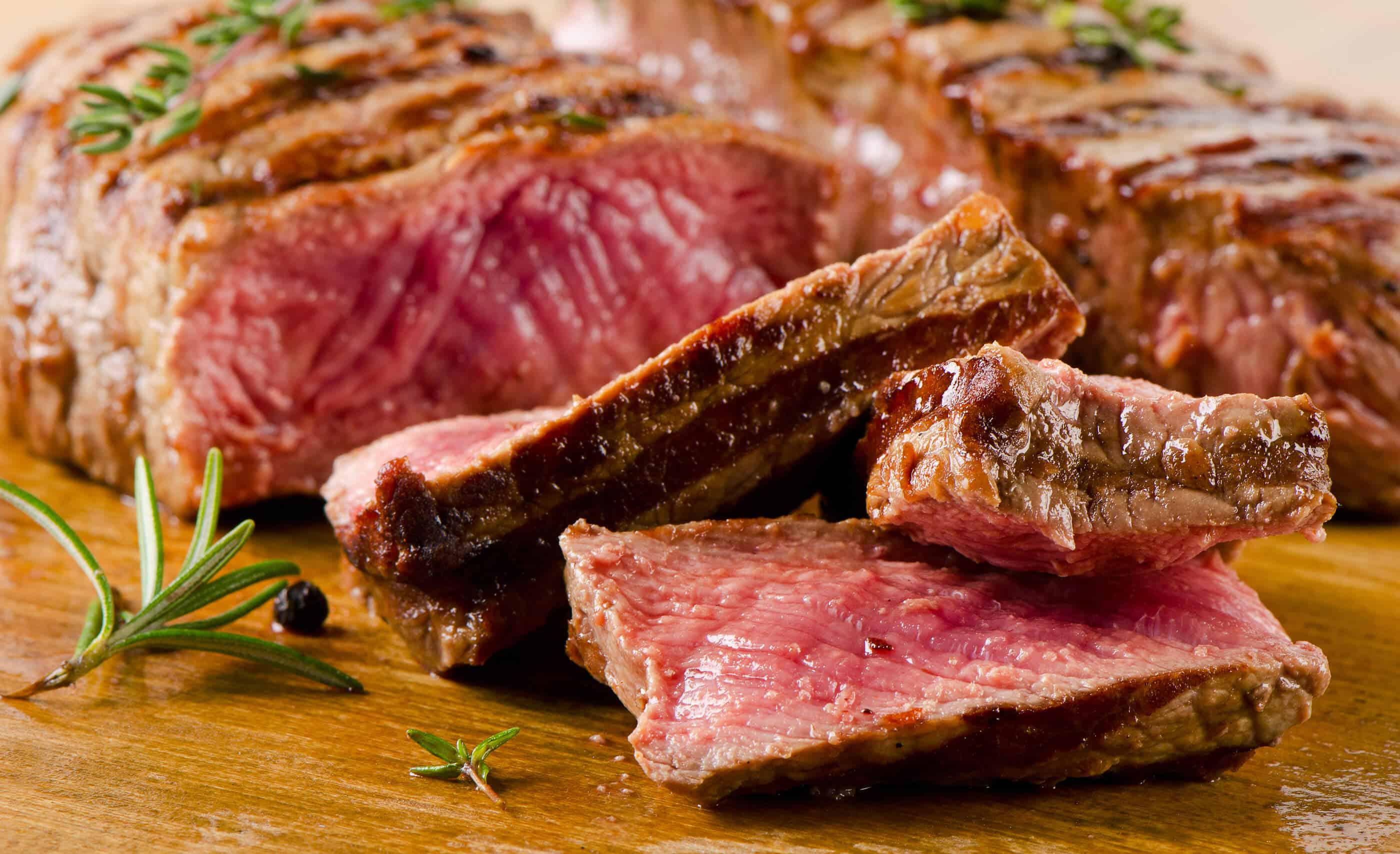 What exactly are proteins? Proteins are considered long chains of amino acids, which are the important molecules we get from our diets. Amino acids can be found in many different types of foods, even vegetables, but the highest sources are those that come from animals — like meat, dairy, eggs and fish — plus to a lesser extent certain plant foods like beans and seeds.
What exactly are proteins? Proteins are considered long chains of amino acids, which are the important molecules we get from our diets. Amino acids can be found in many different types of foods, even vegetables, but the highest sources are those that come from animals — like meat, dairy, eggs and fish — plus to a lesser extent certain plant foods like beans and seeds.
Proteins are long chains of amino acids, which are essential molecules for all metabolic processes. Amino acids, such as glutamine, arginine and glycine, allow for the break down, transport and storage of all nutrients, including proteins, fats, carbohydrates, vitamins, minerals and water.
The body can make some amino acids on its own, but it depends on protein foods to obtain the rest, which are considered “essential” amino acids because we can’t make them. Research shows that amino acids hold great promise in the prevention and treatment of many metabolic diseases, including cardiovascular disorders, infertility, obesity, diabetes and neurological dysfunction. (25)
Although amino acids are separate chemical compounds that are stored in a range of different foods, in the body they’re held together by peptide bonds. Without enough diverse protein food sources in your diet, you risk becoming deficient in certain amino acids. The result? Low energy, trouble building muscle mass, low concentration and memory, mood swings, unstable blood sugar levels, and trouble maintaining or losing weight.
Proteins are used every day to keep the body going. Because they’re used to develop, grow and maintain just about every part of our body — from our skin and hair to our digestive enzymes and immune system antibodies — they’re constantly broken down and must be replaced.
When you don’t eat a range of foods high in protein, you become at risk of deficiencies in certain amino acids, which can result in many health issues. If you are struggling with the following health concerns, it may be due to aprotein deficiency:
- low energy
- mood swings and anxiousness
- a sluggish metabolism
- trouble concentrating or “brain fog”
- unstable blood sugar levels
- difficulty maintaining or losing weight
- trouble building muscle mass
- poor sleep and insomnia
- low immunity
- slow wound healing
- gassiness or constipation
What Makes Some Protein Foods Better Than Others?
The body can make some amino acids on its own, but the rest it must obtain from protein foods. Of the 20 total amino acids there are, certain ones are considered “essential” because these are the specific kinds we aren’t capable of making ourselves. Others are “nonessential” because the body can create them by synthesizing other amino acids.
The 20 different amino acids are all unique and have certain functions in the body, so it’s important to cover your bases and eat a variety of high-protein foods in order to make sure you aren’t lacking certain kinds. Even when an amino acid isn’t essential, it’s more beneficial to obtain it from food since this requires less work for the body.
In the U.S. and most other developed nations, people rarely become severely protein-deficient (a condition called Kwashiorkor). However, many people eat the same foods each day and don’t vary their diets enough to obtain all essential amino acids regularly. So while eating plenty of protein in general is important, it’s also smart to eat a variety of different protein foods.
People following a low-calorie, vegetarian or vegan diet are especially at a higher risk for missing out on important amino acids, since animal foods are considered “complete proteins” (meaning they contain all essential amino acids) but many plant foods are not. It’s possible to combine different plant foods in order to create a combination that has all essential aminos — such as eating rice with beans or vegetables with whole grains, for example — but some health experts believe this is not as optimal as eating foods that are complete protein sources.
What are some top protein food choices that are complete proteins?
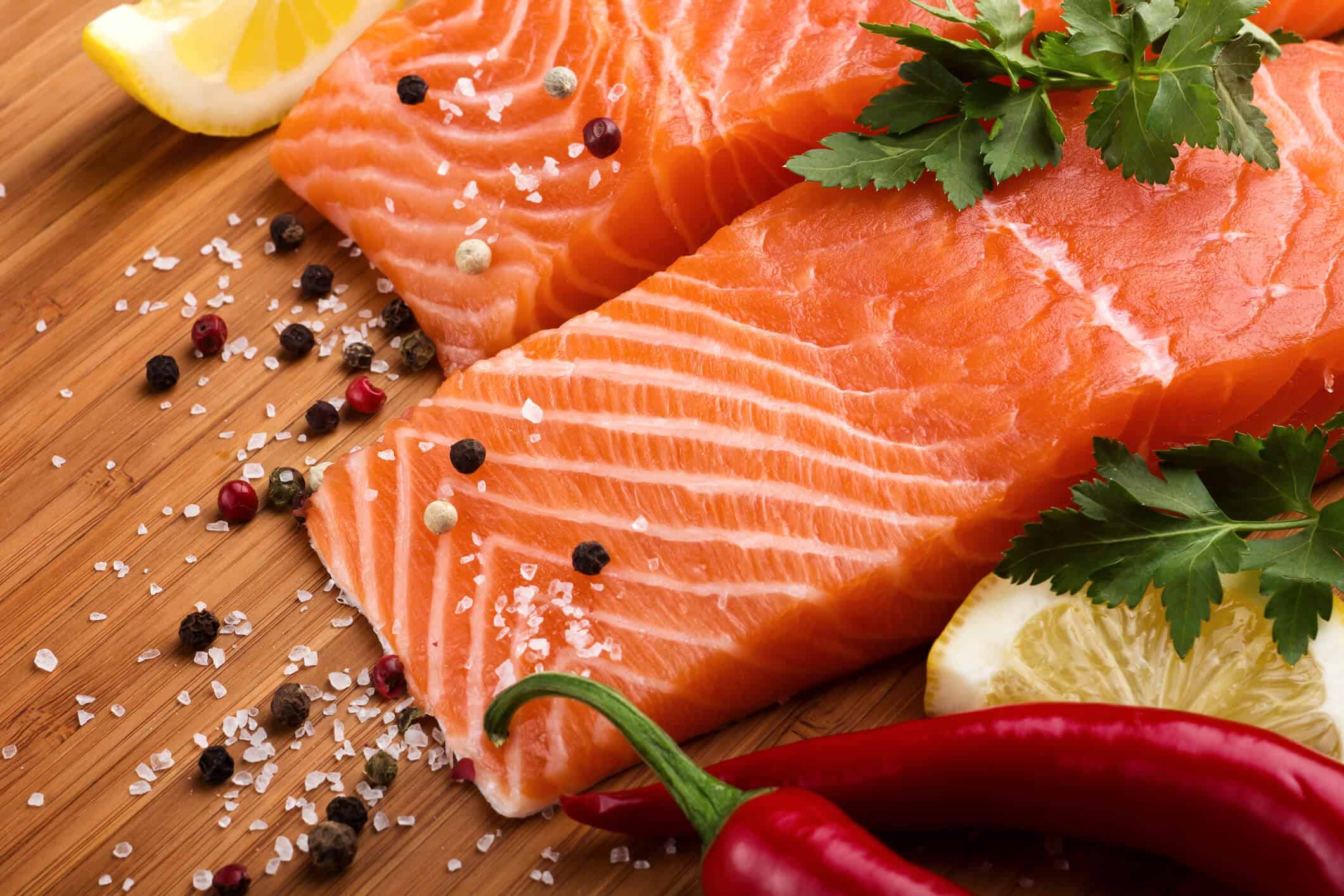
A longer list is below, but some of my favorites include grass-fed beef, raw organic dairy, cage-free eggs and wild-caught seafood. Grass-fed beef contains special immune-boosting conjugated linoleic acid and healthy saturated fats, plus a superior nutritional content than conventionally raised beef. Similarly, bison, venison and lamb are also good choices.
Wild-caught fish is a complete set of amino acids, plus it’s one of the heart-healthy omega-3 foods. Eggs and raw dairy products provide a high level of nutrients in addition to protein, plus they’re versatile and taste great. Raw dairy like yogurt and kefir also provide gut-friendly probiotics that improve digestion and immunity.
One thing to be conscious about is purchasing high-quality protein foods, especially if they’re animal-based. What do I mean by this? Making sure to buy grass-fed meat; organic, cage-free eggs or poultry; raw, unpasteurized dairy; and wild-caught fish is key for obtaining enough protein while also reducing toxins in your diet.
Better quality animal products contain more nutrients over conventionally raised foods since the animals themselves are healthier and fed more natural, nutrient-dense diets. We also know there are some real dangers of farmed fish and livestock when we eat them in large quantities. High-quality proteins provide more trace minerals and vitamins, healthy fatty acids, and contain far less pollutants, heavy metals, or potential synthetic hormones and antibiotics.
Foods High in Protein for Vegetarians/Vegans
You don’t have to eat meat or animal products to follow a high-protein diet. There are actually plenty of foods that contain plant protein. For those of you on a vegetarian or vegan diet, eat plenty of these foods to increase your protein consumption:
- tempeh
- lentils
- beans (black beans, lima beans, pinto beans, chickpeas)
- nuts (almonds, peanuts, pistachios, cashews)
- nut butter (almond butter, cashew butter, sunflower seed butter)
- brown rice
- oats
- quinoa
- seeds (chia seeds, flaxseeds, pumpkin seeds, hemp seeds)
- leafy greens (spinach, kale)
- avocado
- broccoli
- peas
- mushrooms
- Brussels sprouts
Hemp protein powder is another great option for vegetarians and vegans. It’s one of the best plant protein powders because it contains 20 amino acids, including all nine essential amino acids that your body can’t produce on its own. The powder is made from hemp seeds, which have barely or even no measurable levels of THC, so it’s completely healthy, safe and legal. Plus, it contains omega-3 fatty acids, magnesium, iron, potassium and calcium too.
How Many Protein Foods Should We Eat Every Day?
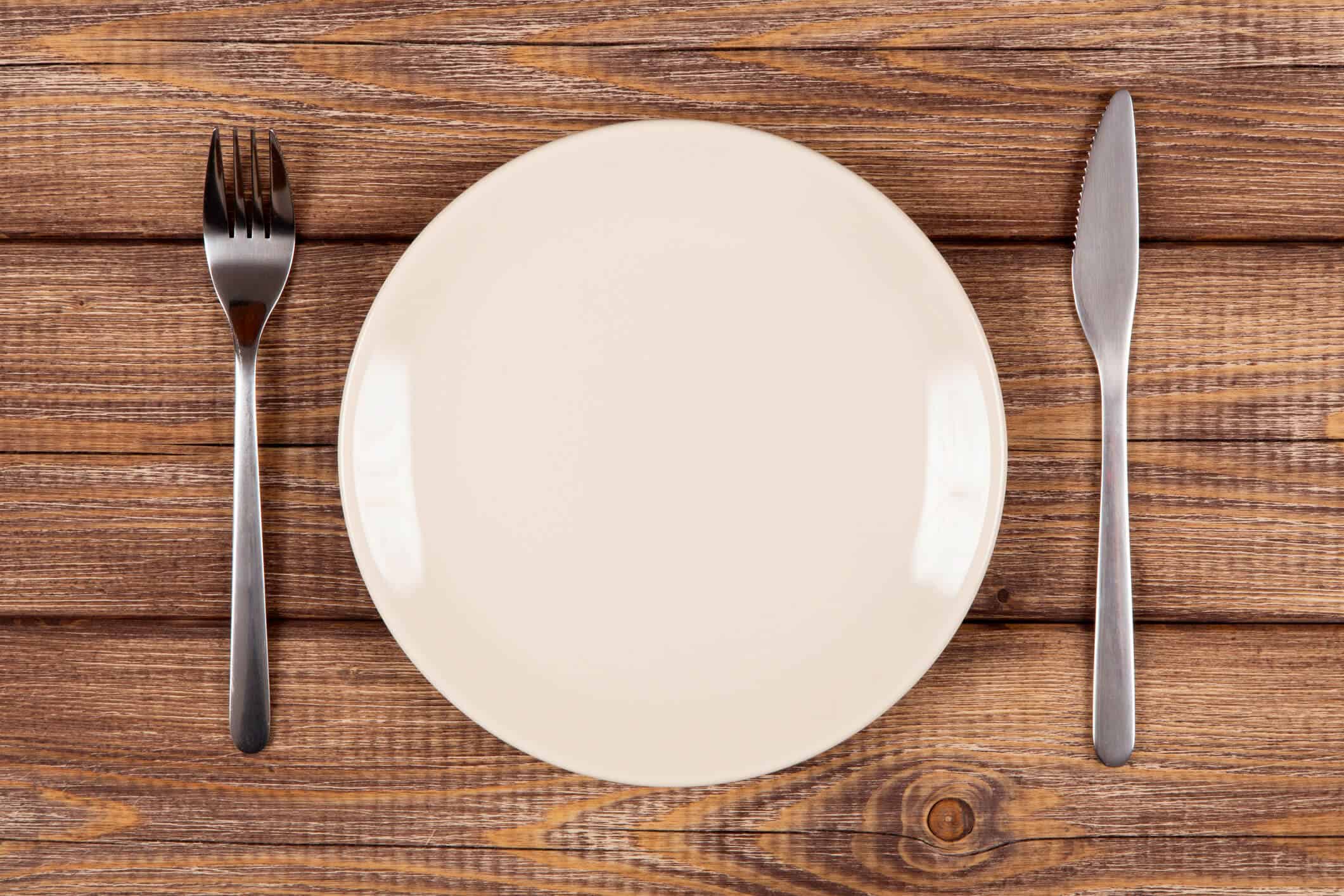
We all need a different level of protein based on our exact needs. For example, your body weight, gender, age, and level of activity or exercise all determine how much protein is best for you. There are also some health conditions that require people to either eat more or less protein than the average person. And athletes need to eat even more foods for energy and performance, including plenty of quality protein.
That being said, there are some general protein guidelines that can serve as a good recommendation to aim for each day. According to the USDA, the recommended daily intake of protein for adults who are at an average weight and activity level is: (26)
- 56 grams per day for men
- 46 grams per day for women
The amounts above are the minimum amount of protein you should aim for each day, assuming you are otherwise healthy and are moderately active. These amounts are equal to eating about 0.36 grams of protein for every pound that you weigh.
More ideally, I recommend you take your body weight and multiply that number by 0.5. The result is the amount in grams of protein you should ideally aim to eat each day. For example, a woman who weighs 150 pounds should aim to eat 75 grams of protein daily, and a man who weighs 180 pounds should shoot for 90 grams.
Overall, I recommend that you make about 30 percent of your plate a high-quality source of protein at every meal. This ensures you eat enough throughout the day to meet your needs and prevents you from overeating carbs and junk foods.
It’s best to eat small amounts of protein throughout the day instead of a very large serving only once or twice. This gives your body the right amount of protein it needs at any given time, since only so much can be utilized at once (the rest will be stored as fat or eliminated). Because your body cannot store protein, eating it throughout the day is the surest way to balance your blood sugar levels, ward off hunger and support your metabolism. This is especially important around the time of exercise when protein-rich pre-workout snacks can go a long way.
How to Follow a High Protein Diet + Benefits
The general rule that I like to follow for consuming protein is eating 50 percent of your body weight in grams of protein per day. Like I said, that means if you weigh 160 pounds, you should be consuming about 80 grams of protein per day. If you’re looking to burn fat on a high-protein diet, then you’ll want to consume even more protein, about 70 percent of your body weight. For people weighing 160 pounds, multiply 160 by 0.7, which gives you 112, so consume close to 100 to 115 grams of protein every day to burn fat more easily.
An easy way to wrap your head around consuming enough protein in one day is to divide the amount of grams you want to eat by the number of meals you consume. If you eat three meals every day and you want to consume 80 grams of protein, then that’s about 25 grams of protein per meal.
Now break that down even further — 25 grams of protein is about a three-ounce serving (about the size of a deck of cards) of grass-fed beef, organic chicken or wild-caught salmon. Combine your meat with a serving of beans and you have plenty of protein in your meal already. Even leafy greens or vegetables like broccoli and Brussels sprouts contain some protein, so adding these vegetables and raw cheese to an omelette is another great way to consume over 25 grams of protein per meal. And to address your mid-day hunger, there are plenty of high-protein snacks that you can turn to, like black bean hummus, yogurt bites, deviled eggs and even cashew butter chocolate chip cookies.
Research shows that a high-protein diet can help you decrease body fat and improve satiety by: (27)
- increasing the secretion of satiety hormones
- reducing appetite-stimulating hormones
- decreasing the need for more food for energy
- improving glucose homeostasis
Following a high-protein diet can help you preserve lean body mass while losing weight. People on a low-calorie diet sometimes notice that along with body fat, they are losing muscle too. Luckily, eating high-protein foods can help you to avoid that. A high-protein diet also creates thermogenesis, a bodily process that requires the body to burn more calories for energy so it can properly digest food. So many diets don’t work because we put ourselves into starvation mode, but a high-protein diet allows you to eat plenty of nutrient-dense, filling foods so you feel full and still lose weight.
Recipes with Foods High in Protein
With such a variety of delicious high-protein foods to choose from, the recipe options are plentiful. You can prepare recipes with one main high-protein ingredient or with a combination of foods that are high in protein. Here are some of my favorite recipes containing a good amount of protein, with both meat and meat-free options:
- Gluten-Free Beef Stroganoff
- Chicken Tikka Masala Recipe
- Cilantro Salmon Burgers
- Turmeric Eggs
- Hummus Recipe
- Keto Smoothie Recipe
And just to give you a few more options, try some of these protein shake recipes and bone broth protein recipes too.
Are There Concerns with Eating Too Much Protein?
Some people are concerned that kidney or liver function can suffer when their diets are too high in protein. However, there isn’t much evidence that a well-rounded diet that has moderate to high levels of high-quality protein will cause problems in otherwise healthy people. (28, 29) Similarly, as mentioned earlier, protein seems to help with bone and heart health, as opposed to preventing risks for worsened health conditions.
That being said, eating very high levels of protein is correlated with some health risks in certain instances. Eating more calories in general than your body can use, whether from protein or another source, will not result in better health and will contribute to weight gain. Very high protein might also lead to digestive problems like constipation, changes in blood sugar levels, and possibly bacteria and yeast growth in the gut.
Neglecting other nutrients and eating a large amount of protein can also put stress on your organs while they work to balance your body’s pH level (since animal foods can be acidic in nature), plus proteins make your body remove more nitrogen waste products from your blood.
Of course, eating a well-rounded diet that’s varied in terms of foods is important for optimal health. Just like you wouldn’t want to consume large amounts of sodium, you do not want to overcome any food. To sum it up, protein plays a big part in a healthy diet, but quality is key — plus you don’t want to simply load up on protein foods all day long without eating enough vegetables, fruit and healthy fats.
Final Thoughts on High-Protein Foods
- The protein found in foods is used by every part of the body to develop, grow and function properly.
- Proteins are long chains of amino acids, which are essential molecules for all metabolic processes.
- When you don’t eat a range of foods high in protein, you become at risk of deficiencies in certain amino acids, which can result in many health issues, including low energy, mood swings, difficulty losing weight, poor sleep, low immunity and unstable blood sugar levels.
- Some of the top foods high in protein include grass-fed beef, organic chicken, lentils, wild-caught salmon, black beans, natto, eggs, yogurt, goat cheese, almonds and protein powder made from bone broth.
- For people who don’t eat animal products, there are plenty of plant-based protein options, including nuts, seeds, beans, leafy greens and grains like quinoa.
- To follow a high-protein diet, eat 50 percent of your body weight in grams of protein per day. If you’re looking to burn fat, consume about 70 percent of your body weight in grams of protein.







